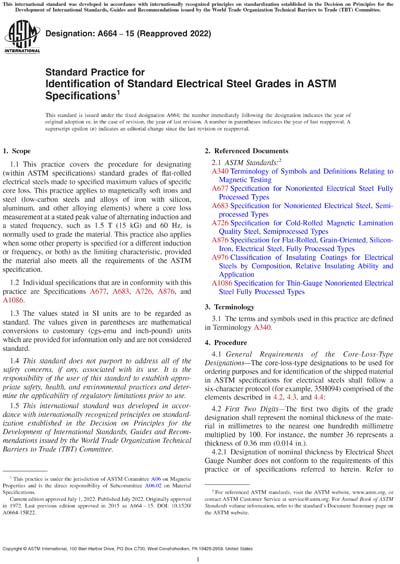Most recent
ASTM A664-15(2022)
Standard Practice for Identification of Standard Electrical Steel Grades in ASTM Specifications
1.1This practice covers the procedure for designating (within ASTM specifications) standard grades of flat-rolled electrical steels made to specified maximum values of specific core loss. This practice applies to magnetically soft irons and steel (low-carbon steels and alloys of iron with silicon, aluminum, and other alloying elements) where a core loss measurement at a stated peak value of alternating induction and a stated frequency, such as 1.5 T (15 kG) and 60 Hz, is normally used to grade the material. This practice also applies when some other property is specified (or a different induction or frequency, or both) as the limiting characteristic, provided the material also meets all the requirements of the ASTM specification.
1.2Individual specifications that are in conformity with this practice are Specifications A677, A683, A726, A876, and A1086.
1.3The values stated in SI units are to be regarded as standard. The values given in parentheses are mathematical conversions to customary (cgs-emu and inch-pound) units which are provided for information only and are not considered standard.
1.4This standard does not purport to address all of the safety concerns, if any, associated with its use. It is the responsibility of the user of this standard to establish appropriate safety, health, and environmental practices and determine the applicability of regulatory limitations prior to use.
1.5This international standard was developed in accordance with internationally recognized principles on standardization established in the Decision on Principles for the Development of International Standards, Guides and Recommendations issued by the World Trade Organization Technical Barriers to Trade (TBT) Committee.
ASTM International [astm]

